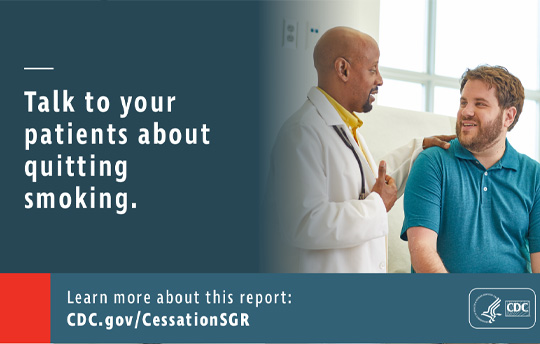 Not sure where to start when it comes to helping your clients or patients quit smoking? Have they tried quitting before but couldn’t do it on their own? Don’t worry. Everyone deserves a fair and just opportunity to live a healthy life, but certain policies, practices, and social or environmental conditions have led to some groups experiencing differences in health or health outcomes. This includes differences in tobacco product use, secondhand smoke exposure, and access to resources that help people quit using tobacco products.
Not sure where to start when it comes to helping your clients or patients quit smoking? Have they tried quitting before but couldn’t do it on their own? Don’t worry. Everyone deserves a fair and just opportunity to live a healthy life, but certain policies, practices, and social or environmental conditions have led to some groups experiencing differences in health or health outcomes. This includes differences in tobacco product use, secondhand smoke exposure, and access to resources that help people quit using tobacco products.
Smoking remains the single largest preventable cause of death and illness in the world and causes over 8 million deaths per year worldwide. In addition, more than 16 million Americans live with a smoking-related disease. While these facts seem daunting, you can still make this their time to quit smoking by providing free resources.
Let the American Cancer Society’s Great American Smokeout event on November 17 inspire them to start their journey toward a smoke-free life. No matter how old someone is or how long they’ve been smoking, there are many benefits to quitting.
For example, soon after quitting, the heart rate decreases and the nicotine level in blood drops to zero. Within a couple of months, coughing and shortness of breath decreases. In 1 to 2 years, the risk of a heart attack drops sharply. The list of benefits goes on and on.
Quitting May Be Harder for Some People Than Others
Some groups of people may have a harder time quitting smoking than others. Although cigarette smoking has declined significantly since 1964, unfair and unjust practices and conditions have led to longstanding disparities in tobacco product use across groups defined by race, ethnicity, educational level, sexual orientation, socioeconomic status, and geographic region. Cigarette smoking may be higher among these groups, like LGBTQ+ people and American Indian/Alaska Native people. These communities may face more challenges when trying to quit. However, many free resources are available. It’s important to keep trying and not give up!
Medicine Can Help People Quit Smoking
Some people need more support to quit smoking than others, and that’s okay. Quit-smoking medicines can make quitting less painful and can more than double the chances of successfully quitting. Seven FDA-approved medicines are proven to help adults quit smoking: nicotine patch, lozenge, gum, oral inhaler, nasal spray, and two pill medicines, varenicline and bupropion. Some medicines are prescribed by a doctor, and others can be found over the counter at a pharmacy. These quit-smoking medicines all work in different ways. They are safe and effective for adults who smoke cigarettes.
About Quit-Smoking Medicines
There are several ways to use quit-smoking medicines that can help them work better. For example, working with a quit coach or counselor can help people get the most out of using medicines and give them the support they need while trying to quit. They can also use some quit-smoking medicines together to reduce symptoms throughout the day and quickly combat cravings as they arise.
Before using any quit-smoking medicine, always read the label first and follow any instructions you receive from your doctor or other health care provider. If you have questions or concerns, speak with your healthcare provider or a pharmacist. Remember to keep helping clients and patients along their quit journey and discuss quit-smoking medicines if you think they will help.
Learn more about free resources at thewellnesscoalition.org/tobacco.
